|
|
|
Sort Order |
|
|
|
Items / Page
|
|
|
|
|
|
|
| Srl | Item |
| 1 |
ID:
120601


|
|
|
|
|
| Publication |
2013.
|
| Summary/Abstract |
This paper contributes to the assessment of China's rural labor markets. According to our data, the increase in off-farm employment that China experienced during the 1980s and 1990s continued during the 2000s. Our analysis shows that migration has become the most prevalent off-farm activity, although the destination of migrants is shifting from outside of one's province to destinations closer to home. The present paper finds that large shares of male and female individuals, especially those under 40 years, are working off the farm. These findings represent an important contribution to the labor economics field. First, the results of the present paper reveal that the labor transition from the agricultural sector to the non-agricultural sector for key segments of China's rural labor force is nearly complete. Second, although a large share of China's rural labor force work in agriculture, most of these workers are older men and women (and likely would not be willing to take low-wage, labor-intensive jobs). Third, the rising unskilled wage rate in China is partially a result of the tightening of the labor force in the young age cohorts. Finally, due to factors associated with the one child policy and other demographic transition forces, successive age cohorts will continue to fall in absolute number in the coming decade. Assuming China's growth continues, we expect to see further wage increases since it will take higher wages to coax more workers to work off the farm.
|
|
|
|
|
|
|
|
|
|
|
|
|
|
|
|
| 2 |
ID:
149742
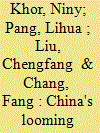

|
|
|
|
|
| Summary/Abstract |
Accumulation of human capital is indispensable to spur economic growth. If students fail to acquire needed skills, not only will they have a hard time finding high-wage employment in the future but the development of the economies in which they work may also stagnate owing to a shortage of human capital. The overall goal of this study is to try to understand if China is ready in terms of the education of its labour force to progress from middle-income to high-income country status. To achieve this goal, we seek to understand the share of the labour force that has attained at least some upper secondary schooling (upper secondary attainment) and to benchmark these educational attainment rates against the rates of the labour forces in other countries (e.g. high-income/OECD countries; a subset of G20 middle-income/BRICS countries). Using the sixth population census data, we are able to show that China's human capital is shockingly poor. In 2010, only 24 per cent of China's entire labour force (individuals aged 25–64) had ever attended upper secondary school. This rate is less than one-third of the average upper secondary attainment rate in OECD countries. China's overall upper secondary attainment rate and the attainment rate of its youngest workers (aged 25–34) is also the lowest of all the BRICS countries (with the exception of India for which data were not available). Our analysis also demonstrates that the statistics on upper secondary education reported by the Ministry of Education (MoE) are overestimated. In the paper, we document when MoE and census-based statistics diverge, and raise three possible policy-based reasons why officials may have begun to have an incentive to misreport in the mid-2000s.
|
|
|
|
|
|
|
|
|
|
|
|
|
|
|
|
| 3 |
ID:
121213
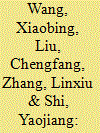

|
|
|
|
|
| Publication |
2013.
|
| Summary/Abstract |
The opportunity to attend college and earn a degree has increased dramatically in China. However, that does not mean that everyone has an equal opportunity. Historically, there has been well-documented systematic discrimination against minorities, women and the rural poor. The main question of this paper is whether or not this discrimination has persisted since the recent expansion of China's tertiary education system. Using a census of incoming freshmen from four tier one universities, this paper assesses if certain types of students are over-represented while other types of students are under-represented. Comparing the shares of students from different socioeconomic and ethnic backgrounds from our primary survey data with government generated census statistics, we conclude that poor, minority and rural female students are systematically under-represented. In contrast, rich, Han, urban males are dominant in college.
|
|
|
|
|
|
|
|
|
|
|
|
|
|
|
|
| 4 |
ID:
120621
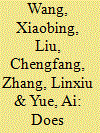

|
|
|
|
|
| Publication |
2013.
|
| Summary/Abstract |
The rapid expansion of enrollment capacity in China's colleges since the late 1990s has come at the price of high tuition hikes. China's government has put forth financial aid programs to enable poor students to access higher education. Although studies have shown that poor high school students are indeed able to attend college when their test scores are high enough (that is, few are unable to attend when they are qualified to attend), the literature has not explored whether poor students have sufficient amounts of aid to thrive in college.
Using findings from a randomized controlled trial, this study evaluates the impact of providing full scholarships to students from poor rural areas (henceforth treatment students) on student stress levels, self-esteem/self-efficacy, and participation in activities in four first-tier colleges. To do so, we compare outcomes of the treatment students with students who were not given full scholarships by the project (and were left to search for scholarships and other sources of financial aid from the university system itself-the control students). The project was run among the 200 poorest first-year students in four first-tier colleges in inland China. Somewhat surprisingly, we find that treatment students (those receiving full scholarships from the project) were only slightly more successful in obtaining financial aid than control students. This suggests that control students (those who did not receive full scholarships from the project) were still able to access comparable levels of financial aid. Most importantly, scholarship recipients were statistically identical in outcome to control students in terms of stress, self-esteem, and participation in college activities, suggesting that poor students (who are dependent on aid from the university system) currently are able to access sufficient levels of financial aid, are able to take advantage of the activities offered at college, and do not shoulder heavy financial or psychological costs.
We find, therefore, that efforts of the government to alleviate the financial burden of college on the poor have been relatively successful in first-tier colleges. Because of this, foundations and individuals may decide that if they want to improve human welfare, giving additional scholarships at high tier colleges may be having little effect.
|
|
|
|
|
|
|
|
|
|
|
|
|
|
|
|
| 5 |
ID:
133270


|
|
|
|
|
| Publication |
2014.
|
| Summary/Abstract |
China's rapid economic growth has been facilitated by its large volume of rural to urban migration. China's projected future development, especially increasing urbanization, implies that such migration will further intensify. However, migration does not come without cost. There are concerns about the potential negative impacts of migration on children's care, education, and, in particular, the self-esteem of children left behind in villages where one or both parents have out-migrated to cities. In this paper, we employ unique survey data collected from Shaanxi Province, where more than 4700 ninth grade students from 36 rural junior high schools in five counties were surveyed in late 2011. The results show that having both parents migrate into cities significantly reduced children's self-esteem. The effects are also gender sensitive. Girls that had a father or both parents who had out-migrated were inclined to have lower self-esteem than boys. Moreover, our study findings indicate that parental migration decreased children's self-esteem more for individuals with initial low self-esteem.
|
|
|
|
|
|
|
|
|
|
|
|
|
|
|
|
| 6 |
ID:
120606
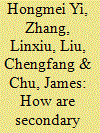

|
|
|
|
|
| Publication |
2013.
|
| Summary/Abstract |
Drawing on a survey of 106 secondary vocational schools and 7309 students in two provinces of China, this descriptive paper assesses whether vocational schooling is measuring up to government benchmarks for quality and whether poor students are able to access quality schools. We find that secondary vocational schools have met government benchmarks for teacher qualification and training, student opportunities for practical training and adequate facilities. Furthermore, poor students access schools of similar quality to non-poor students, even though 34 percent of poor students do not receive financial aid. We conclude that recent policies are successfully ensuring secondary vocational school quality and equity of access to school quality between poor and non-poor students. However, financial aid policies should be re-examined, such that poor students receive sufficient coverage. Moreover, given that input-based measures only proxy school quality, the government should consider holding schools accountable for outcomes such as student learning.
|
|
|
|
|
|
|
|
|
|
|
|
|
|
|
|
| 7 |
ID:
145581
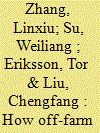

|
|
|
|
|
| Summary/Abstract |
Using three-wave survey data for four villages of Jiangsu Province in China, the present paper examines whether and to what extent off-farm employment affects the technical efficiency of agricultural production. The level of technical efficiency is measured using a stochastic frontier production function approach. Based on estimation results from instrumental variable panel quantile regressions we find that there is a positive significant effect of off-farm employment on the level of farm technical efficiency. We also find that fragmentation of farmland is a barrier to the improvement of technical efficiency. In addition, we find a downward trend in the level of agricultural technical efficiency among our sample. Therefore, the Chinese Government should stimulate agricultural mechanization and the development of farming techniques to improve technical efficiency in the context of increasing off-farm employment.
|
|
|
|
|
|
|
|
|
|
|
|
|
|
|
|
| 8 |
ID:
145584


|
|
|
|
|
| Summary/Abstract |
This study describes the current teacher training system in China, including the prevalence of teacher training, the types of training, training content and the ways that training is delivered. The paper presents subjective evaluations of training for principals and teachers using four diverse datasets. The results show that the National Teacher Training Project (NTTP) deviates from official policy objectives in several respects. The subjects of training programs and training content are not fully compliant with policy objectives. In addition, training opportunities are offered to a smaller proportion of rural teachers than urban teachers. It is found that the proportion of teachers and principals satisfied with the NTTP is lower than that for other types of training. Therefore, measures should be taken to increase training opportunities for rural teachers and to ensure the quality of training for all teachers.
|
|
|
|
|
|
|
|
|
|
|
|
|
|
|
|
| 9 |
ID:
086698
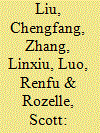

|
|
|
|
|
| Publication |
2009.
|
| Summary/Abstract |
Although quality may be as important as quantity in public infrastructure management, little research has studied changes in the quality of China's infrastructure investments. This study seeks to document the quality of infrastructure projects in China's villages and to measure whether or not quality has suffered as China's investment effort has risen. The study also examines if satisfaction is rising. Using data from 100 villages in China, we have found that both the quantity and the quality of infrastructure investments have increased. We also find that rural residents are more satisfied with projects, especially when they are higher quality.
|
|
|
|
|
|
|
|
|
|
|
|
|
|
|
|
|
|
|
|
|